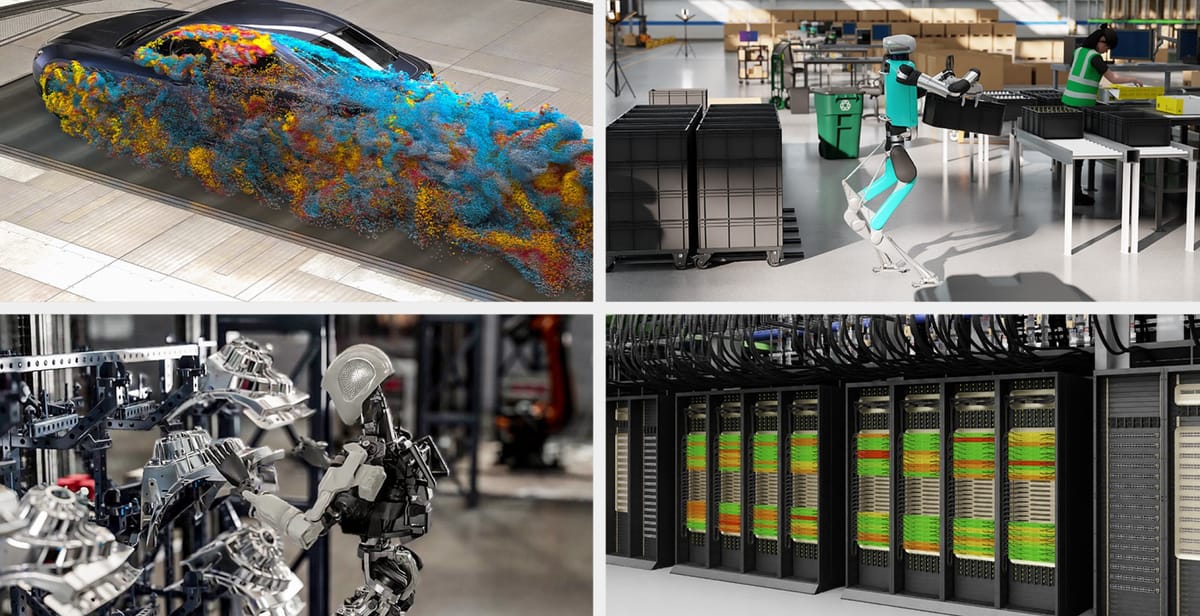
NVIDIA is making a strategic bet on physical AI. During his opening keynote at GTC 2025, CEO Jensen Huang didn’t mince words when he declared robotics “could very well likely be the largest industry of all!” Behind this ambitious vision sits the company's rapidly maturing Omniverse platform, now supercharged with the newly announced Cosmos world foundation models.
Key Points:
- Omniverse serves as the platform connecting industrial data to physical AI development
- Cosmos world foundation models generate synthetic training data at scale
- Major manufacturers like Mercedes-Benz and Foxconn use these virtual environments to train robotics systems
- Cloud availability on AWS, Azure and Oracle increases accessibility for developers
When NVIDIA first introduced Omniverse to the mainstream, much of the focus was on its capabilities as a visualization platform, illustrated by partnerships with companies like WPP for marketing applications. Today, the company's vision has expanded considerably, with industrial applications taking center stage.
NVIDIA's Omniverse platform is evolving into what company executives describe as an "operating system for physical AI" – reflecting how customers are increasingly using the technology to train robots and autonomous systems in virtual environments before physical deployment.
"Think about omniverse as, first and foremost, a development platform for building physical AI or simulation applications," explained James McKenna, NVIDIA's global product marketing manager for Omniverse for digital twins, in an interview with Maginative. "Developers are using it to build the next generation of AI applications that connect physical data in a way that's not been possible before."
This approach is proving valuable for companies that have invested in building digital replicas of their factories and warehouses. These businesses are now leveraging Omniverse to train and test robots, humanoids, and other autonomous systems in a safe, cost-effective way before deploying them in the physical world.
A significant addition to Omniverse is NVIDIA Cosmos, a set of world foundation models designed to generate synthetic data at scale for training physical AI systems. This addresses one of the biggest challenges in developing embodied AI: the need for massive, diverse datasets.
"Think of it as a 3D to 2D synthetic data generation pipeline," McKenna said. "The simulation environments and blueprints developed with Omniverse and Cosmos enable developers to generate vast amounts of diverse, photoreal data to train physical AI."
The combination of Omniverse and Cosmos enables companies to overcome data limitations by generating synthetic training data representing countless scenarios, including edge cases that rarely occur in real-world operations but are critical for robust AI systems.
Mercedes-Benz exemplifies this approach. Having built digital twins on NVIDIA's technology over several years, the automaker is now using these simulations with Cosmos to train Apptronik's Apollo humanoid robots for vehicle assembly operations. Similarly, Hyundai Motor Group is simulating Boston Dynamics Atlas robots on its assembly lines.
Supporting these implementations is NVIDIA's new MEGA Blueprint, available now in preview, which enables testing of multi-robot fleets at scale in industrial digital twins. MEGA allows companies to simulate heterogeneous robot fleets working together in virtual replicas of their facilities.
In electronics manufacturing, Foxconn is using the combination of Omniverse, MEGA, and Cosmos to develop its manufacturing operations for the NVIDIA Blackwell platform.
"Foxconn is constantly exploring ways to transform our operations as we continue our journey toward building the factories of the future," said Brand Cheng, CEO of Fii, a core subsidiary of Foxconn. "Using NVIDIA Omniverse and MEGA, we're testing and training humanoids to operate in our leading factories as we advance to the next wave of physical AI."
Despite the focus on industry, McKenna emphasized that it's not all about manufacturing. In fact, NVIDIA deliberately designed Omniverse to be very generalizable, and as such developers are using it across different domains for various use cases. Unilever's Chief Growth and Marketing Officer, Esi Eggleston Bracey, shared that they are using Omniverse to create pixel perfect product twins to help boost product desirability, reduce complexity and accelerate content creation.
"We've transformed what was once a complex, slow process into a marketing system that frees up our teams to focus on what they do best – think bigger, be creative, push boundaries and create magic for our brands."
To increase accessibility, NVIDIA is making Omniverse available across major cloud platforms. It's now available as virtual desktop images on AWS Marketplace with NVIDIA L40S GPUs, and the Microsoft Azure Marketplace features preconfigured Omniverse instances. Oracle Cloud Infrastructure and Google Cloud integrations are expected later this year.
"The cost to actually get started developing significantly reduces because effectively, you know, function of how many hours are consuming those instances as a developer," McKenna said.
As robots and autonomous systems become central to industrial automation strategies, the ability to generate synthetic training data and validate AI models in virtual environments will be critical. With the updates to Omniverse and the new Cosmos foundation models, NVIDIA is addressing this growing market need, and potentially accelerating the adoption of physical AI while reducing implementation risks. If Huang's prediction about robotics becoming the largest industry proves correct, NVIDIA's early and persistent investment may prove to be its most consequential strategic bet yet.

